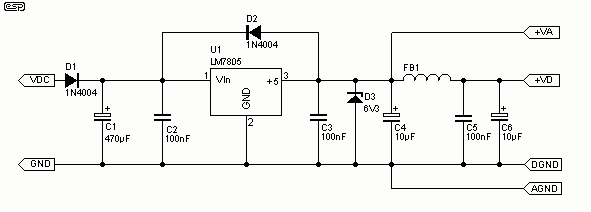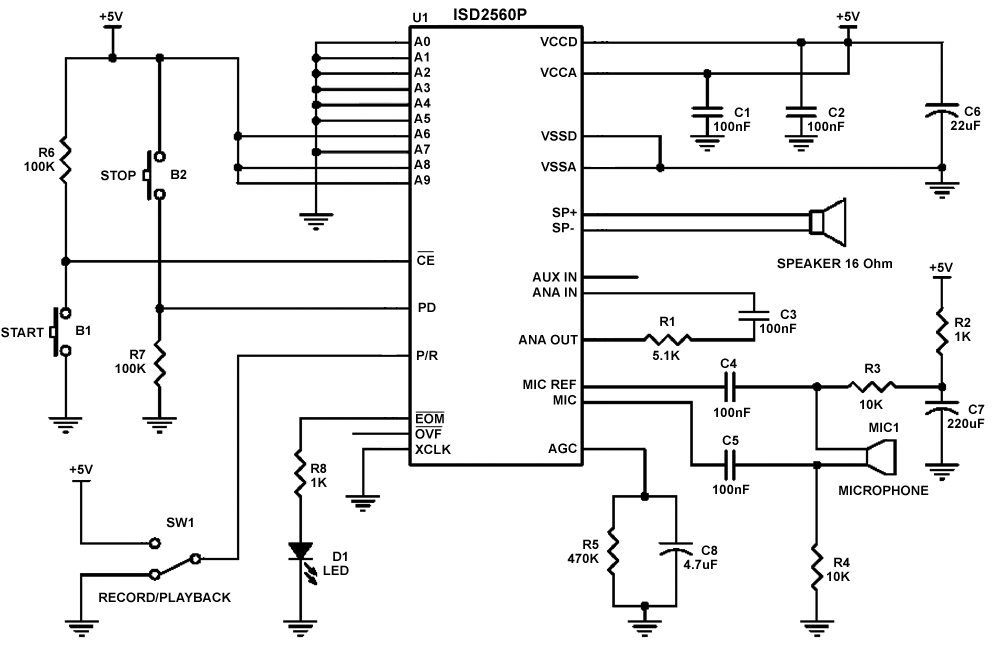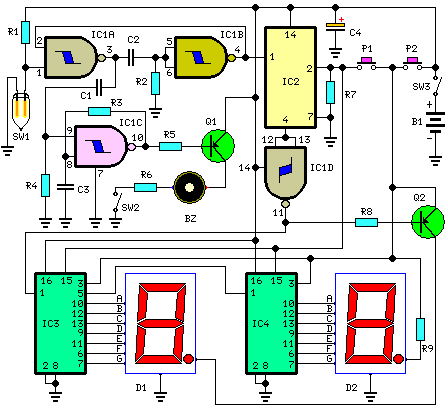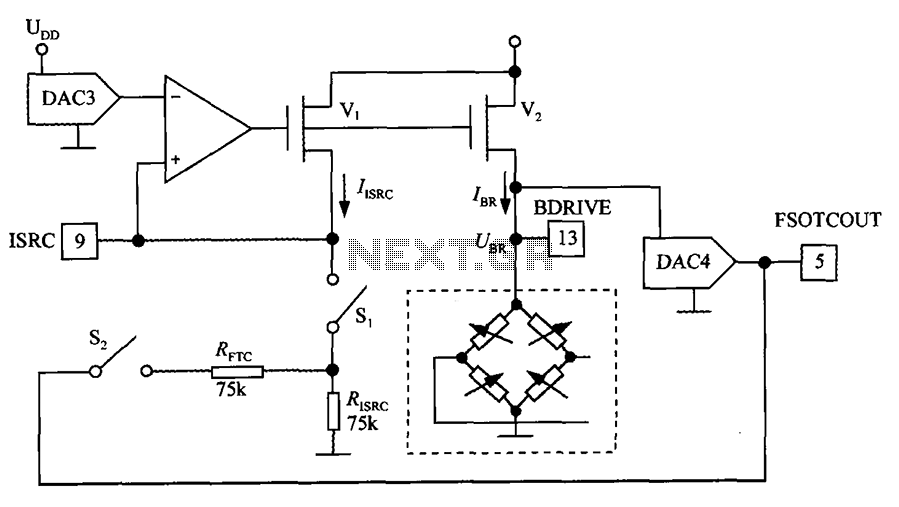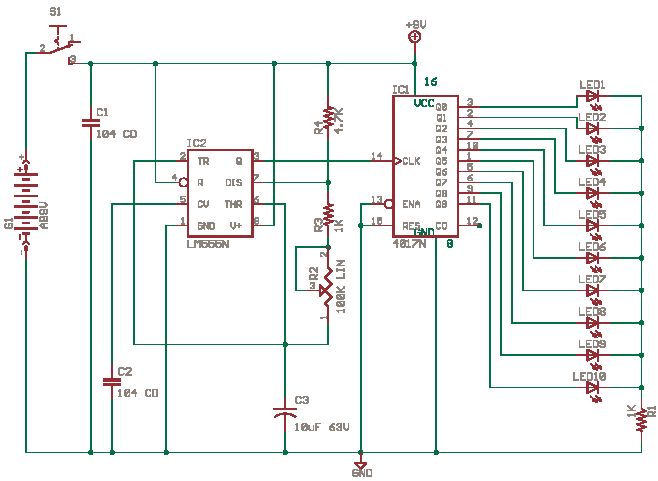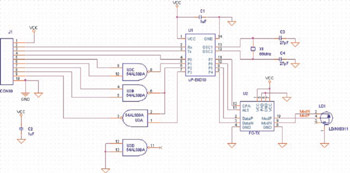
Digital Step-Km Counters
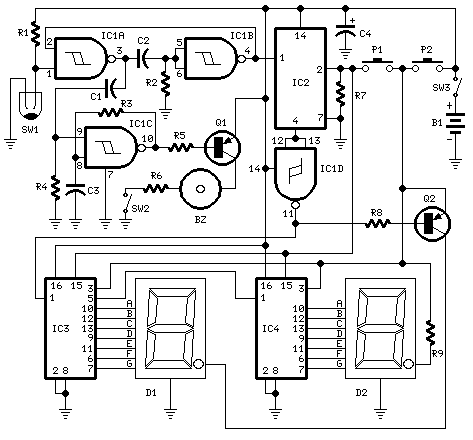
This circuit measures the distance covered during a walk. The hardware is housed in a small box that can be slipped into a pocket, and the display is designed as follows: the leftmost display D2 (the most significant digit) shows distances from 0 to 9 kilometers, with its dot always illuminated to separate kilometers from hectometers. The rightmost display D1 (the least significant digit) indicates hundreds of meters, lighting its dot after every 50 meters of walking. A beeper, which can be disabled, signals each unit count, which occurs every two steps. A standard step is estimated to span approximately 78 centimeters, meaning the LED indicating 50 meters lights up after 64 steps or 32 activations of the mercury switch. The display shows 100 meters after 128 steps, and so forth. To conserve battery power, the display only lights up upon request by pressing P2. Accidental reset of the counters is prevented, as both pushbuttons must be activated simultaneously to reset the circuit. While this device is not a precision meter, its degree of approximation has been deemed satisfactory for its intended use. The placement and angle of the mercury switch within the box are critical for accurate operation. IC1A and IC1B form a monostable multivibrator that mitigates excessive bouncing of the mercury switch, ensuring a clean square pulse is sent to IC2, which divides the pulse by 64. Q2 illuminates the dot of D1 for every 32 pulses counted by IC2. IC3 and IC4 each divide by 10 and drive the displays. P1 resets the counters, while P2 activates the displays. IC1C generates an audio frequency square wave, which is activated briefly at each monostable count. Q1 drives the piezo sounder, and SW2 allows the beep to be disabled. This circuit is primarily designed for walking purposes, with additional care required in mercury switch placement for jogging to avoid erroneous counts.
The circuit utilizes a microcontroller or a combination of integrated circuits to process the signals from the mercury switch, which acts as a step counter. The distance calculation is based on the assumption of a fixed step length, which is a simplification that works well for general walking but may require calibration for individual users. The use of a monostable multivibrator (IC1A and IC1B) is essential for filtering out noise and ensuring that only valid transitions from the mercury switch are counted, thus improving the accuracy of distance measurement.
The display output is managed by a multiplexing technique, where IC3 and IC4 serve to drive the two seven-segment displays, allowing for the visualization of both kilometers and hectometers. The design includes a user-friendly interface with two pushbuttons: P1 for resetting the distance counter and P2 for activating the display, which helps in extending battery life by only powering the display when needed.
The beeping sound generated by the piezo sounder serves as an auditory feedback mechanism, allowing the user to keep track of their step count without requiring constant visual confirmation from the display. The ability to disable the beep via SW2 adds to the flexibility of the device, catering to user preferences in different environments.
Overall, this circuit exemplifies a compact and efficient design for a distance measurement device, making it suitable for casual walkers and joggers alike, while highlighting the importance of component selection and placement for achieving reliable performance.This circuit measures the distance covered during a walk. Hardware is located in a small box slipped in pants` pocket and the display is conceived in the following manner: the leftmost display D2 (the most significant digit) shows 0 to 9 Km. and its dot is always on to separate Km. from hm. The rightmost display D1 (the least significant digit) sh ows hundreds meters and its dot lights after every 50 meters of walking. A beeper (excludable), signals each count unit, which occurs every two steps. A normal step is calculated to span approx. 78 centimeters, thus the LED signaling 50 meters lights after 64 steps or 32 mercury switch`s operations, the display indicates 100 meters after 128 steps and so on. For low battery consumption the display lights only on request, pushing P2. Accidental reset of the counters is avoided because to reset the circuit both pushbuttons must be operated together.
Obviously this is not a precision meter, but its approximation`s degree was found good for this kind of device. In any case, the most critical thing to do is placement and sloping degree of the mercury switch inside the box.
IC1A & IC1B form a monostable multivibrator providing some degree of freedom from excessive bouncing of the mercury switch. Therefore a clean square pulse enters IC2 that divide by 64. Q2 lights the dot of D1 every 32 pulses counted by IC2. IC3 & IC4 divide by 10 each and drive the displays. P1 resets the counters and P2 enables the displays. IC1C generates an audio frequency square wave that is enabled for a short time at each monostable count.
Q1 drives the piezo sounder and SW2 let you disable the beep. This circuit is primarily intended for walking purposes. For jogging, further great care must be used with mercury switch placement to avoid undesired counts. 🔗 External reference
The circuit utilizes a microcontroller or a combination of integrated circuits to process the signals from the mercury switch, which acts as a step counter. The distance calculation is based on the assumption of a fixed step length, which is a simplification that works well for general walking but may require calibration for individual users. The use of a monostable multivibrator (IC1A and IC1B) is essential for filtering out noise and ensuring that only valid transitions from the mercury switch are counted, thus improving the accuracy of distance measurement.
The display output is managed by a multiplexing technique, where IC3 and IC4 serve to drive the two seven-segment displays, allowing for the visualization of both kilometers and hectometers. The design includes a user-friendly interface with two pushbuttons: P1 for resetting the distance counter and P2 for activating the display, which helps in extending battery life by only powering the display when needed.
The beeping sound generated by the piezo sounder serves as an auditory feedback mechanism, allowing the user to keep track of their step count without requiring constant visual confirmation from the display. The ability to disable the beep via SW2 adds to the flexibility of the device, catering to user preferences in different environments.
Overall, this circuit exemplifies a compact and efficient design for a distance measurement device, making it suitable for casual walkers and joggers alike, while highlighting the importance of component selection and placement for achieving reliable performance.This circuit measures the distance covered during a walk. Hardware is located in a small box slipped in pants` pocket and the display is conceived in the following manner: the leftmost display D2 (the most significant digit) shows 0 to 9 Km. and its dot is always on to separate Km. from hm. The rightmost display D1 (the least significant digit) sh ows hundreds meters and its dot lights after every 50 meters of walking. A beeper (excludable), signals each count unit, which occurs every two steps. A normal step is calculated to span approx. 78 centimeters, thus the LED signaling 50 meters lights after 64 steps or 32 mercury switch`s operations, the display indicates 100 meters after 128 steps and so on. For low battery consumption the display lights only on request, pushing P2. Accidental reset of the counters is avoided because to reset the circuit both pushbuttons must be operated together.
Obviously this is not a precision meter, but its approximation`s degree was found good for this kind of device. In any case, the most critical thing to do is placement and sloping degree of the mercury switch inside the box.
IC1A & IC1B form a monostable multivibrator providing some degree of freedom from excessive bouncing of the mercury switch. Therefore a clean square pulse enters IC2 that divide by 64. Q2 lights the dot of D1 every 32 pulses counted by IC2. IC3 & IC4 divide by 10 each and drive the displays. P1 resets the counters and P2 enables the displays. IC1C generates an audio frequency square wave that is enabled for a short time at each monostable count.
Q1 drives the piezo sounder and SW2 let you disable the beep. This circuit is primarily intended for walking purposes. For jogging, further great care must be used with mercury switch placement to avoid undesired counts. 🔗 External reference
